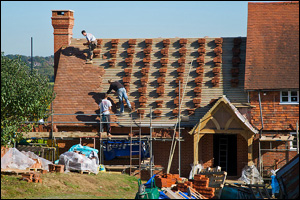 Energy efficiency is increasingly important these days. There are many ways you can upgrade your existing home but if you are about to build a new home, you have a lot more options. Making your new home energy efficient from the start will drastically reduce your energy bills and lower your home’s environmental footprint.
Energy efficiency is increasingly important these days. There are many ways you can upgrade your existing home but if you are about to build a new home, you have a lot more options. Making your new home energy efficient from the start will drastically reduce your energy bills and lower your home’s environmental footprint.
Design Features
One of the most effective ways to make your new home energy efficient is to use passive solar design to situate your house to take advantage of the sun’s ability to warm it. This means the house will face south and have lots of windows on the south side.
Likewise, there will be few windows on the west side and even fewer on the north side. The roof overhangs will be designed to block the rays of the hot summer sun and admit the sun’s rays in winter. You can also situate your house to take advantage of cooling breezes in hot climates or to block winter winds in cold climates.
Exterior Options
A great way to make your home energy efficient on the outside is to construct your home out of materials that do well in your climate. Cob and adobe are great materials to use in the Southwest, for example, because they provide the thermal mass needed to keep the house cool during the day and warm at night. Likewise, straw bale houses are good for the Midwest because they provide needed insulation for cold winters.
Another way to increase the energy efficiency of your home on the exterior is to select energy efficient doors and windows. These should be Energy Star rated. Doors can also be insulated. You can even select siding options that will help insulate your home or put rigid foam insulation behind the siding. In addition, you can insulate all below grade walls and carefully seal all joints as the house is being constructed.
Interior Options
Because you are building a home from scratch, you can make the interior of your home extremely energy efficient. For example, you can build-in a radiant barrier. You can choose to insulate all the walls to at least R-21 and the roof and attic to at least R-49. You can make sure that the heating and cooling system is properly sized and install an energy-efficient unit. You can also make sure all of your lights are either compact fluorescents or LEDs.
Installing a tankless hot water heater is another great way to boost your energy efficiency, and these heaters are often hard to retrofit, so designing them into a new house will save you headaches in the long run. A solar hot water heater is another option to consider.
A programmable thermostat will ensure that your house stays comfortable while you still save money on your heating and cooling bills. A radiant floor heating system is a great way to lower your heating bill. Energy Star rated models are available for all the appliances you will need, from refrigerators to washers and dryers. You can design the interior to minimize plumbing runs and thus reduce energy loss when hot water is pumped to the bathrooms or the washing machine.
If you use passive solar design, you can even use the flooring and furnishings to help heat your new home in the winter. Everything absorbs solar radiation when exposed to it, and the larger and heavier the object, the more solar radiation it absorbs. This energy is then released at night when the surrounding room cools off. To take advantage of this effect you can put in heavy floors, such as stone, and choose heavy furniture.
About the author: Jeff is experienced content writer and blogger for a few home improvement websites where he is sharing his tips and advices about preserving and improving house space. Currently, he is working as a content contributor for Arvernebythesea.com.
Credits Photo courtesy of Julian Berry.